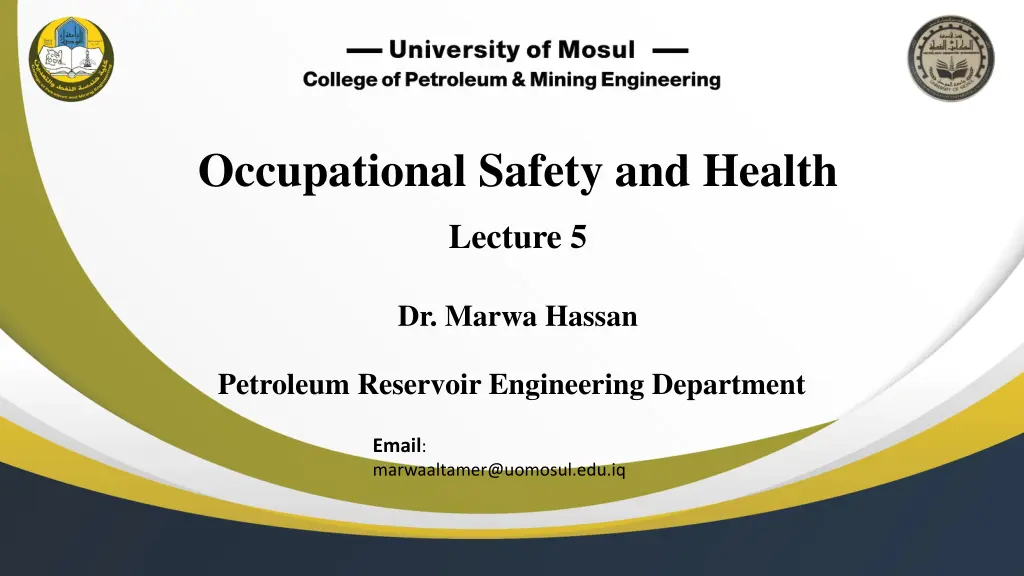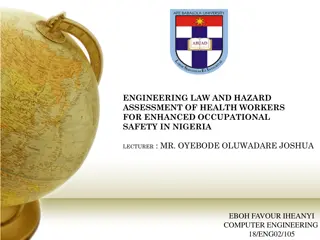
Understanding Chemical and Pressure Hazards in Occupational Safety
Learn about the risks associated with chemical burns and pressure hazards in the workplace, including factors impacting severity and safety measures. Gain insights into occupational safety and health practices to prevent injuries and protect personnel.
Download Presentation

Please find below an Image/Link to download the presentation.
The content on the website is provided AS IS for your information and personal use only. It may not be sold, licensed, or shared on other websites without obtaining consent from the author. If you encounter any issues during the download, it is possible that the publisher has removed the file from their server.
You are allowed to download the files provided on this website for personal or commercial use, subject to the condition that they are used lawfully. All files are the property of their respective owners.
The content on the website is provided AS IS for your information and personal use only. It may not be sold, licensed, or shared on other websites without obtaining consent from the author.
E N D
Presentation Transcript
Occupational Safety and Health Lecture 5 Dr. Marwa Hassan Petroleum Reservoir Engineering Department Email: marwaaltamer@uomosul.edu.iq
LECTURE CONTENTS Burns and Their Effects
Chemical Burns Chemicals are widely used in modern industry even by companies that do not produce them as part of their product base. Many of the chemicals produced, handled, stored, transported or otherwise used in industry can cause burns similar to those caused by heat (i.e., first-, second-, and third-degree burns). The hazards of chemical burns are very similar to those of thermal burns. Chemical burns, like thermal burns, destroy body tissue; the extent of destruction depends on the severity of the burn. However, chemical burns continue to destroy body tissue until the chemicals are washed away completely.
The severity of the burn produced by a given chemical depends on the following factors: Corrosive capability of the chemical Concentration of the chemical Temperature of the chemical or the solution in which it is dissolved Duration of contact with the chemical
Pressure Hazards Pressure is defined in physics as the force exerted against an opposing fluid or thrust distributed over a surface. This may be expressed in force or weight per unit of area, such as pounds per square inch (psi). A hazard is a condition with the potential of causing injury to personnel, damage to equipment or structures, loss of material, or lessening of the ability to perform a prescribed function. Thus, a pressure hazard is a hazard caused by a dangerous condition involving pressure. Critical injury and damage can occur with relatively little pressure. The Occupational Safety and Health Administration (OSHA) defines high- pressure cylinders as those designated with a service pressure of 900 psi or greater.
We perceive pressure in relation to the earths atmosphere. Approximately 21 % of the atmosphere is oxygen, with most of the other 79 % being nitrogen. In addition to oxygen and nitrogen, the atmosphere contains trace amounts of several inert gases: argon, neon, krypton, xenon, and helium. Atmospheric pressure is usually measured using a barometer. As the altitude above sea level increases, atmospheric pressure decreases in a nonlinear fashion. For example, at 5,486 meters (18,000 feet) above sea level, the barometric pressure is equal to 390 mm Hg. Half of this pressure, around 195 mm Hg, can be found at 2,010 meters (23,000 feet) above sea level.
Sources of Pressure Hazards There are many sources of pressure hazards-some natural, most created by humans. Because the human body is made up of approximately 85 % liquid, which is virtually incompressible, increasing pressure does not create problems by itself. Problems can result from air being trapped or expanded within body cavities. When sinus passages are blocked so that air cannot pass easily from the sinuses to the nose, expansion of the air in these sinuses can lead to problems. The same complications can occur with air trapped in the middle ear s eustachian tube. As Boyle s law states, gas volume increases as pressure decreases. Expansion of the air in blocked sinus passages or the middle ear occurs with a rapid increase in altitude or rapid ascent underwater. This can cause pain and, if not eventually relieved, disease. Under extreme circumstances of rapid ascent from underwater diving or high-altitude decompression, lungs can rupture.
Boilers and Pressure Hazards A boiler is a closed vessel in which water is heated to form steam, hot water, or high-temperature water under pressure. Potential safety hazards associated with boilers and other pressurized vessels include the following: Design, construction, or installation errors Poor or insufficient training of operators Human error Mechanical breakdown or failure Failure or blockage of control or safety devices Insufficient or improper inspections Improper application of equipment Insufficient preventive maintenance







